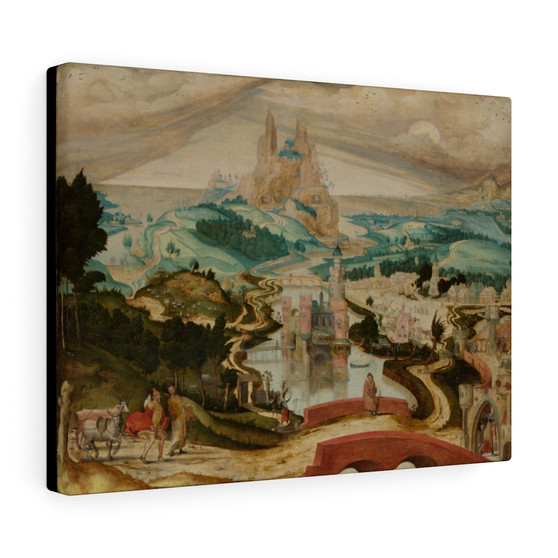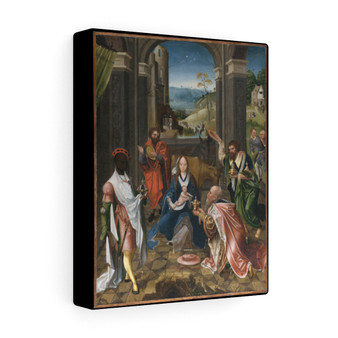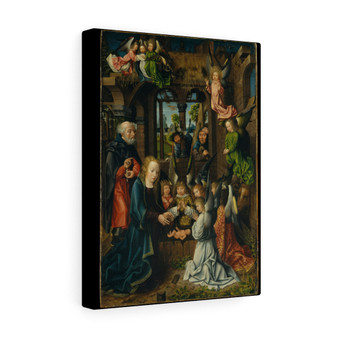Product Description
The Arrival in Bethlehem, ca. 1540, Attributed to Master LC, Netherlandish. Historical artwork in public domain. In this picture, the viewer is invited to travel along with Joseph and Mary, who set out on their journey at the lower left. Farther along their way they are shown in the village, at an inn where they are refused entry. At the far right they appear again, kneeling in a courtyard in adoration of the newborn Christ. The development of landscape painting as an independent genre advances in this picture beyond the works of Patinir, since the religious narrative is more fully integrated into the extensive landscape. It is unfinished, and the underdrawing is easily seen with the naked eye. Title: The Arrival in Bethlehem Artist: Attributed to Master LC (Netherlandish, active second quarter 16th century) Date: ca. 1540 Medium: Oil on wood References on the original James Schmidt in Les anciennes écoles de peinture dans les palais et collections privées russes, représentées à l'exposition organisée à St.-Pétersbourg en 1909 par la revue d'art ancien "Staryé gody". Exh. cat.Brussels, 1910, pp. 59–61, no. 402, identifies the subject of our panel as Landscape with the Nativity; rejects the attribution to Patinir [see Exhs. Saint Petersburg 1908–1909]; ascribes it to Cornelis Massys based on some similarities to his painting of Saint Jerome [Koninklijk Museum voor Schone Kunsten, Antwerp]; notes that the current owner, Count Golénitscheff-Koutousoff, bought it in Vienna as the work of Abraham Hassler. B[rysson]. B[urroughs]. "An Imaginary Landscape." Metropolitan Museum of Art Bulletin 11 (June 1916), pp. 129–30, considers it unlikely to be by Patinir as it is dissimilar to his four indisputably authentic works. Eliot Clark. "On a Picture by Patinir." Art in America 7 (1919), pp. 44–45, 47–48, ill., discusses the technique. Marrion Wilcox. "Joachim Patinir." Art & Life 11 (March 1920), pp. 470, 472, ill., lists it with pictures less confidently attributed to Patinir. Alfred M. Frankfurter. "Masterpieces of Landscape Painting in American Collections." Fine Arts 18 (December 1931), pp. 22, 27, ill., as by Cornelis Massys. Bryson Burroughs. Landscape Paintings. Exh. cat., The Metropolitan Museum of Art. New York, 1934, pp. 5, 15, no. 15, ill., as an unfinished painting by Cornelis Massys. Max J. Friedländer. Die altniederländische Malerei. Vol. 13, Anthonis Mor und seine Zeitgenossen. Leiden, 1936, p. 35, mentions is as a work by an eccentric follower of Cornelis Massys, along with two other paintings in the Plandiura collection at Barcelona (Museu Nacional d’Art de Catalunya) and in a private collection in Dresden. Harry B. Wehle and Margaretta Salinger. The Metropolitan Museum of Art: A Catalogue of Early Flemish, Dutch and German Paintings. New York, 1947, pp. 118–19, ill., as by Cornelis Massys; observe that a Landscape with Saint Jerome (Koninklijk Museum voor Schone Kunsten, Anwterp, no. 830), dated 1543 and signed by Cornelis Massys, is very close in style, but "lacks the clumsy figures and certain curious tree forms"; mention a painting of the same subject by Cornelis (Kaiser Friedrich Museum, Berlin) . Julius S. Held. "Book Reviews: Harry B. Wehle and Margaretta M. Salinger . . ., 1947." Art Bulletin 31 (June 1949), p. 140. Holbein and His Contemporaries. Exh. cat., John Herron Art Museum. Indianapolis, 1950, unpaginated, no. 49, ill. Josephine L. Allen and Elizabeth E. Gardner. A Concise Catalogue of the European Paintings in The Metropolitan Museum of Art. New York, 1954, p. 64. Maurice W. Brockwell. "A Little Known Landscape Painter: Lucas Gassel's 'Baptism of Christ'." Connoisseur 138 (September 1956), p. 18, observes that this painting, once ascribed to Joachim Patinir and now assigned to Cornelis Massys, is distantly related in style to the works of Lucas Gassel. Erik Larsen. Les primitifs flamands au Musée Metropolitain de New York. Utrecht, 1960, pp. 87, 129, fig. 31. Leo van Puyvelde. La peinture flamand au siècle de Bosch et Breughel. Paris, 1962, p. 234, notes similarities to the paintings of Cornelis Masys, but finds the composition of the foreground like Lucas Gassel. Giorgio T. Faggin. La pittura ad Anversa nel Cinquecento. Florence, 1968, p. 39 n. 18, rejects the attribution to Lucas Gassel and instead, ascribes it to a master he calls "Pseudo-Gassel", who painted Christ at the Sea of Tiberias in the Torres collection, Madrid, and the landscape with the Calling of Saint Matthew (Musées Royaux des Beaux-Arts de Belgique, Brussels), which bears the monogram L.C. Simone Bergmans. 22. Ausstellung, Herbst 1969. Exh. cat., Galerie Friederike Pallamar. Vol. 22, Vienna, 1969, p. 21, rejects the attribution to Cornelis Massys and considers it to be more likely the work of Lucas Gassel. Burton L. Dunbar. "The Landscape Art of Cornelis Massys." PhD diss., University of Iowa, 1972, pp. 252–54, no. P27, fig. 54, as by a contemporary of Cornelis Massys (Lucas Gassel?). Max J. Friedländer et al. Early Netherlandish Painting. Vol. 13, Antonis Mor and His Contemporaries. New York, 1975, p. 22. Burton L. Dunbar. "The Landscape Paintings of Cornelis Massys." Bulletin des Musées Royaux des Beaux-Arts de Belgique 23–29 (1981), pp. 116–17, ill., ascribes this picture and several other compositions to Lucas Gassel; compares it with the Calling of Saint Matthew in Brussels [see Ref. Faggin 1968]. Maryan W. Ainsworth. Memo to Everett Fahy. January 25, 1988, recognizes the same hand in the Calling of Saint Matthew in Brussels, which is signed with the initials "L.C.". Walter S. Gibson. "Mirror of the Earth": The World Landscape in Sixteenth-century Flemish Painting. Princeton, 1989, pp. 20–21, 96–97 nn. 31–32, 34, attributes it to the "Master of the Brussels-New York Panels," a follower of Lucas Gassel, and lists several related works which may be by the same hand. Luc Serck. "Henri Bles & la peinture de paysage dans les pays-bas méridionaux avant Bruegel." PhD diss., Université Catholique de Louvain, 1990, vol. 6, pp. 1252–53, pl. C.1, ascribes it with eleven other pictures to the Master of the Brussels Calling of Saint Mattew (Monogrammist L.C.); characterizes the artist as an original landscape painter who was influenced by the graphic technique of Herri met de Bles and the matte tones of Lucas Gassel. Maryan Ainsworth and J. J. Walker. "MOSART Software for Constructing Infrared Reflectograms." Le dessin sous-jacent dans la peinture. Ed. Hélène Verougstraete-Marcq and Roger van Schoute. Colloque 8, Louvain-la-Neuve, 1991, pp. 157–58, pl. 85 (infrared reflectogram), as by Herry met de Bles. Katharine Baetjer. European Paintings in The Metropolitan Museum of Art by Artists Born Before 1865: A Summary Catalogue. New York, 1995, p. 272, ill. Maryan W. Ainsworth. "A Meeting of Sacred and Secular Worlds." From Van Eyck to Bruegel: Early Netherlandish Painting in The Metropolitan Museum of Art. Ed. Maryan W. Ainsworth and Keith Christiansen. Exh. cat., The Metropolitan Museum of Art. New York, 1998, pp. 208, 266, 268, 270–71, 326, no. 71, ill. (color), as "Attributed to Master LC," about 1540; notes that at a certain point the painting process was interrupted and somewhat later taken up again, probably by a second artist, who suppressed the religious narrative and sprinkled genre motifs throughout the composition. Maryan W. Ainsworth. "An Unfinished Landscape Painting Attributed to the Master LC and Sixteenth-Century Workshop Practice." Herri Met de Bles: Studies and Explorations of the World Landscape Tradition. Ed. Norman E. Muller et al. Turnhout, Belgium, 1998, pp. 117–18, 121–27, nn. 1–2, 20–21, 24, p. 128, ill. (infrared reflectogram and black and white details), colorpl. 15, notes that the "graphic mannerisms and certain landcape features" of its underdrawing "are so close [to Gassel] that they appear to have originated in the same workshop"; finds the light brownish-orange of the foreground pathways and the pale lime green of the hills in the middle distance particularly characteristic of works attributed to Master LC, as is the placement of the essential features of the narrative in the foreground. Luc Serck in Autour de Henri Blés. Ed. Jacques Toussaint. Exh. cat., Musée des Arts Anciens du Namurois. [Namur], 2000, pp. 272, 274, ill. Designed for indoor use, custom stretched canvas prints are made from treated cotton - providing the smoothest of matte surfaces for exceptional design vividity. A combination of quality and durability, these hangings come with a lifelong color guarantee; there's significant confidence in their withstanding the test of time. On the backside, pre-installed hanging hardware ensures proper locking to walls.
.: 100% cotton fabric
.: Wooden frame
.: High image quality and detail
.: For indoor use




















